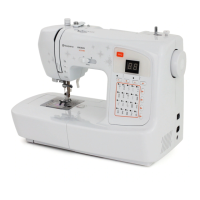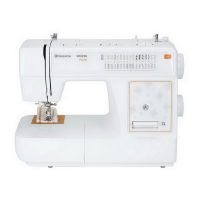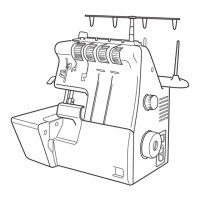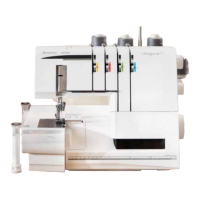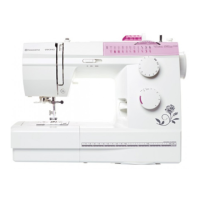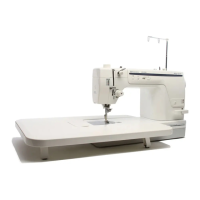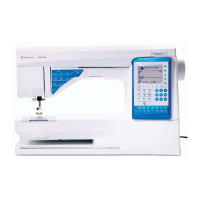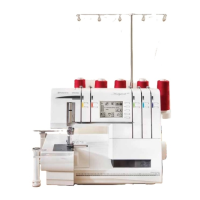
Do you have a question about the Husqvarna Viking Viking Huskylock s25 and is the answer not in the manual?
| Type | Serger |
|---|---|
| Model | Huskylock s25 |
| Differential Feed | Yes |
| Adjustable Cutting Width | Yes |
| Presser Feet | Snap-on |
| Built-in Stitch Cutter | Yes |
| Free Arm | Yes |
| Number of Threads | 2, 3, 4 |
| Stitch Length | 1 - 4 mm |
| Stitch Width | 3 - 7 mm |
| Speed | 1300 stitches per minute |
| Needles | Standard 130/705H |
| Threading | Color-coded threading system |
| Dimensions | 32 x 28 x 30 cm |
Basic safety precautions to mitigate electric shock hazards when operating the sewing machine.
General safety warnings and precautions to prevent injury or harm to users during operation.
Instructions for connecting the foot control and power supply to the sewing machine.
How to insert and use the spool stand for holding thread spools.
Instructions for extending and using the telescopic thread stand.
Guide on how to attach the waste tray to the sewing machine.
Steps to open the front cover of the sewing machine.
Steps to close the front cover of the sewing machine.
Information about the type of needles used and their specifications.
Step-by-step guide on how to change the needles in the sewing machine.
Explanation of how to use the presser foot lift lever.
Detailed instructions on how to change the presser foot.
How to disengage and engage the movable upper cutter for different sewing needs.
Instructions on engaging and disengaging the 2-thread overlock converter.
How to disengage and engage the upper looper for specific stitches.
Explanation of the stitch finger lever settings for different stitches.
Steps to install the Coverstitch table C for specific sewing.
Introduction to the SEWING ADVISOR feature for fabric selection and settings.
A detailed overview of the touch screen interface and its functions.
How to use the SEWING ADVISOR to select fabric and get recommendations.
Guide on how to select different stitches using the touch screen.
How to interpret and use stitch recommendations displayed on the screen.
How to adjust stitch settings like tension, length, and differential feed.
Detailed steps for adjusting thread tension settings for optimal results.
How to adjust the stitch length using the touch screen controls.
Instructions on adjusting the differential feed for various fabric types.
How to adjust the sewing speed using the touch screen.
How to save custom stitch settings for future use.
Steps to overwrite an existing saved stitch.
How to delete a previously saved personal stitch.
Instructions for loading a saved personal stitch.
Guide to accessing and adjusting machine settings like contrast and sound.
How to access detailed information about selected stitches.
Explanation of various pop-up messages and their meanings.
General guidelines and color-coding for threading the machine.
Recommended needles and threads for different fabric weights.
Detailed steps for threading the upper looper with green color coding.
Detailed steps for threading the lower looper with blue color coding.
Instructions for threading the chainstitch/coverstitch looper with purple color coding.
Step-by-step guide to threading the right needle with red color coding.
Step-by-step guide to threading the left needle with yellow color coding.
How to thread the left/chainstitch needle with yellow color coding.
Detailed instructions for threading the right coverstitch needle.
Steps to thread the middle coverstitch/chainstitch needle with red color coding.
How to thread the left coverstitch needle with yellow color coding.
Instructions on using the needle threader accessory.
Method for changing threads easily without re-threading the entire machine.
A comprehensive overview of all available stitches and their settings.
Details for the 4-thread overlock stitch, including uses and settings.
Information on the 4-thread safety stitch, wide, for joining and overcasting.
Details for the 4-thread safety stitch, narrow, for joining and overcasting.
Guide to the 3-thread overlock wide stitch for stretchy or light fabrics.
Instructions for the 3-thread overlock narrow stitch for common fabrics.
How to use the 3-thread narrow edge stitch for stretchy or light fabrics.
Details on the 3-thread flatlock stitch, wide, for stretchy fabrics and decorative effects.
Instructions for the 3-thread flatlock stitch, narrow, for stretchy fabrics and decorative effects.
Guide to the 3-thread wrapped overlock stitch for finishing lightweight fabric edges.
Instructions for the 3-thread wrapped overlock stitch for finishing lightweight fabric edges.
How to sew extra stretchy fabrics with the 3-thread stretch overlock stitch.
Instructions for using the 3-thread rolled edge stitch for lightweight fabrics.
Details on the 2-thread overlock wide stitch for light to medium fabrics.
Information on the 2-thread overlock narrow stitch for light to medium fabrics.
How to use the 2-thread narrow edge stitch for lightweight fabrics.
Guide to the 2-thread flatlock wide stitch for stretchy fabrics and decorative effects.
Instructions for the 2-thread wrapped overlock wide stitch for decorative finishing.
Details on the 2-thread wrapped overlock narrow stitch for fine fabrics.
How to use the 2-thread rolled edge stitch for lightweight fabrics with a satin edge.
Instructions for triple coverstitch for hems and decorative effects on stretch fabrics.
Details on wide coverstitch for hems and decorative effects on stretch fabrics.
Instructions for narrow coverstitch for hems and decorative effects on stretch fabrics.
Guide to chainstitch for construction, hemming, and piecing quilts.
Basic steps to begin sewing, including pin placement and chaining off.
How to achieve a rolled edge by adjusting tension and stitch finger.
Setup and steps for performing coverstitch sewing for hems and bindings.
Procedures for securing the end of a coverstitch seam to prevent unraveling.
Explanation of flatlock stitches for construction and embellishment.
Steps for creating a standard flatlock stitch with fabric pieces.
How to create an ornamental flatlock stitch for decorative effects.
How to create a ladder stitch using right sides of fabric together.
Instructions for chainstitch sewing, including machine setup and operation.
Guide for sewing circles using the extension table and specific stitch settings.
Various tips for sewing techniques like pintucks and braiding.
How to adjust stitch width using needle position or the cutting width dial.
Adjusting stitch width by selecting different needle positions.
Fine-tuning stitch width using the dedicated cutting width dial.
How to adjust the presser foot pressure for different fabric types.
Explanation of the differential feed system and its adjustment.
Adjusting differential feed for gathered overlock on stretch and knit fabrics.
Adjusting differential feed for stretch overlock on lightweight fabrics.
Guidance on fine-tuning thread tensions for various stitches and fabrics.
Instructions for cleaning the sewing machine, including the touch screen.
Guide on lubricating the machine's moving parts with the recommended oil.
Steps for replacing a dull movable upper cutter.
Guidelines for storing the sewing machine properly when not in use.
Common problems and their solutions for fabric feeding, stitches, and machine operation.
Recommendations for regular servicing and seeking dealer assistance.
Information regarding warranty coverage for non-original parts.
Physical dimensions of the sewing machine including width, length, height, and weight.
